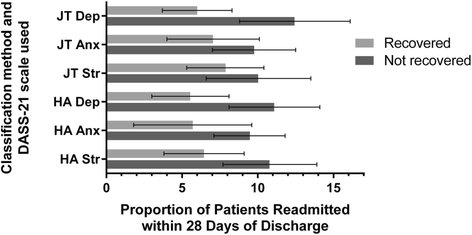Validity of clinically significant change classifications yielded by Jacobson-Truax and Hageman-Arrindell methods
- PMID: 27267986
- PMCID: PMC4895887
- DOI: 10.1186/s12888-016-0895-5
Validity of clinically significant change classifications yielded by Jacobson-Truax and Hageman-Arrindell methods
Abstract
Background: Reporting of the clinical significance of observed changes is recommended when publishing mental health treatment outcome studies and is increasingly used in routine outcomes monitoring systems. Since recovery rates vary with the method chosen, we investigated the validity of classifications of clinically significant change when the Jacobson-Truax method and the Hageman-Arrindell method were used.
Methods: Of 718 inpatients who completed the Depression Anxiety Stress Scales (DASS-21) and Quality of Life Enjoyment and Satisfaction Questionnaire at admission and discharge to a psychiatric clinic, 355 were invited (and 119 agreed) to complete the questionnaires and the Recovery Assessment Scale six weeks post discharge.
Results: Both the JT and HA methods showed comparably good validity when referenced against the other indices. Clinically significant change on the DASS-21 was related to a greater consumer-based sense of recovery, greater perceived quality of life, and fewer readmissions to hospital within 28 days of discharge.
Conclusions: Since there was found to be no advantage to using one method over another when recovery is of interest, the simpler JT method is recommended for routine usage.
Keywords: Clinical significance; Outcomes; Quality of life; Recovery; Validity.
Figures
Similar articles
-
Clinically significant and practical! Enhancing precision does make a difference. Reply to McGlinchey and Jacobson, Hsu, and Speer.Behav Res Ther. 1999 Dec;37(12):1219-33. doi: 10.1016/s0005-7967(99)00036-4. Behav Res Ther. 1999. PMID: 10596468
-
Clinically significant but impractical? A response to Hageman and Arrindell.Behav Res Ther. 1999 Dec;37(12):1211-7; discussion 1219-33. doi: 10.1016/s0005-7967(99)00035-2. Behav Res Ther. 1999. PMID: 10596467
-
Evaluating the clinical significance of responses by psychiatric inpatients to the mental health subscales of the SF-36.J Affect Disord. 2007 Feb;98(1-2):91-7. doi: 10.1016/j.jad.2006.07.001. Epub 2006 Aug 10. J Affect Disord. 2007. PMID: 16904752
-
Assessing clinical significance of treatment outcomes using the DASS-21.Psychol Assess. 2013 Dec;25(4):1103-10. doi: 10.1037/a0033100. Epub 2013 Jun 3. Psychol Assess. 2013. PMID: 23730826
-
Systematic reviews of the effectiveness of day care for people with severe mental disorders: (1) acute day hospital versus admission; (2) vocational rehabilitation; (3) day hospital versus outpatient care.Health Technol Assess. 2001;5(21):1-75. doi: 10.3310/hta5210. Health Technol Assess. 2001. PMID: 11532238 Review.
Cited by
-
Integrative systematic review of psychodrama psychotherapy research: Trends and methodological implications.PLoS One. 2019 Feb 19;14(2):e0212575. doi: 10.1371/journal.pone.0212575. eCollection 2019. PLoS One. 2019. PMID: 30779787 Free PMC article.
-
Comparison of false positive and false negative rates of two indices of individual reliable change: Jacobson-Truax and Hageman-Arrindell methods.Front Psychol. 2023 Jul 13;14:1132128. doi: 10.3389/fpsyg.2023.1132128. eCollection 2023. Front Psychol. 2023. PMID: 37519369 Free PMC article.
-
Health economic evaluation of a randomized controlled trial (EMBLA study), an internet-based treatment for provoked vulvodynia.Sci Rep. 2023 Apr 17;13(1):6242. doi: 10.1038/s41598-023-33406-6. Sci Rep. 2023. PMID: 37069199 Free PMC article. Clinical Trial.
-
Longitudinal Estimation of the Clinically Significant Change in the Treatment of Major Depression Disorder.Front Psychol. 2018 Aug 6;9:1406. doi: 10.3389/fpsyg.2018.01406. eCollection 2018. Front Psychol. 2018. PMID: 30127761 Free PMC article.
-
Effect of Seclusion on Mental Health Status in Hospitalized Psychiatric Populations: A Trial Emulation using Observational Data.Eval Health Prof. 2024 Mar;47(1):3-10. doi: 10.1177/01632787231164489. Epub 2023 Mar 10. Eval Health Prof. 2024. PMID: 36898680 Free PMC article.
References
-
- Jacobson NS, Follette WC, Revenstorf D. Psychotherapy outcome research: methods for reporting variability and evaluating clinical significance. Behav Ther. 1994;15:336–52. doi: 10.1016/S0005-7894(84)80002-7. - DOI
Publication types
MeSH terms
LinkOut - more resources
Full Text Sources
Other Literature Sources
Medical


